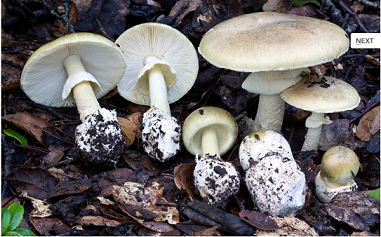Nutrition
The basic rule of life is that all organisms must feed and obtain nutrients one way or another. For the Amanita phalloides and all fungus in general, such as the Lycoperdon pyriforme, or the wolf-fart puffball. Another example of the fungal feeding method lies in the Calvatia gigantea. All fungi are heterotrophic in nature so they do not possess the ability to produce any of their own food. For instance some people may think that at first glance, the fungus are actually plants when in fact this is completely wrong. Fungi do not possess the ability to photosynthesize so light levels do not affect the feeding habits of fungi anywhere or in any location. To see a closer look at photosynthesis check out the Purple Coneflower or the Echinacea purpurea! For fungi to obtain the nutrients and material needed for growth and life, absorption of decaying material must take place. When decaying material happens upon the Death cap, exoenzymes are released. Exoenzymes are specialized enzymes that are projected outside of the fungal body that break down organic material externally. Once the exoenzymes are released, the process of breaking down the organic material begins. Once the organic material has been broken down, the fungus then releases its' hyphae which in turn slowly absorb the food into its body. This process is the general feeding structure of fungi around the globe, in varying degrees of habitats and climates.
For a further look at exoenzymes check out the video below! (Please note: If in Internet Explorer, please click show all content at the bottom of your page to watch video.)
Credit to Gabriel Guzman for use of this video! Thanks!
The other mode of nutrition, specific to the Amanita phalloides, is the mutualistic relationship shared with multiple species of trees but mainly the great and wondrous oak tree. In this interaction, the death cap receives nutrients and other materials from the oak tree's photosynthesis and the oak tree receives nitrogen and other chemicals from the fungus itself. But this interaction will be discussed next on the page titled Interactions.
i
<--Return to Adaptations On to Reproduction-->
Home